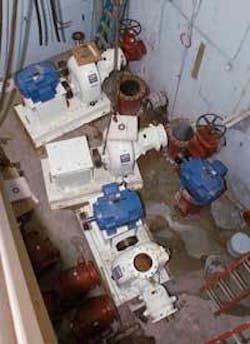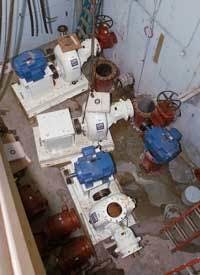Savings, Efficiency Delivered to Pennsylvania Township
Hampden Township, located in idyllic southeastern Pennsylvania near Mechanicsburg, is home to more than 25,000 residents. The township’s wastewater treatment facility is a modern plant fed by suburban transfer stations throughout the area. Pump station No. 8 is a wet well/dry well lift station outfitted with three dry pit submersible pumps. The site is also one of the busiest stations, pumping upwards of 2,500 gallons of sewage per minute.
“Due to the frequency and high cost of constantly repairing the dry pit submersible pumps, we decided to replace them with more dependable and efficient Gorman-Rupp T-series pumps,” said Tom Fealtman, Township Collection System Foreman.
He had good reason; the old pumps were costing the township $15,000 every four-to-five years for repairs and were using excessive amounts of electricity to complete tasks.
Many municipalities only consider the initial purchase price and installation cost of wastewater pumping equipment. There are many other factors to be considered when deciding on the type of equipment to serve a wastewater pumping station. When considering the options, the township and partners took into consideration the total cost of owning wastewater pumps.
Serving the public comes first
The principal problem with taking down pumps (in this scenario) is that the community’s wastewater doesn’t stop for the maintenance process. Having a solution that continues township services during the renovation was critical.
To maintain services while repairs took place, the team installed three Gorman-Rupp above ground pumps - two PA6C models and one RP4G model to handle the sewage flow as the eight-inch pumps were being replaced. These pumps bypassed the pump station and forwarded, at peak, more than 5.2 million gallons of waste per day to a treatment facility three miles away.
All three electric pumps operate on a float system, meaning that if the primary pump’s float reaches a certain level due to heavy rain or in the event of a mechanical failure, an alternate pump kicks on. Although each pump is capable of pumping 2,500 gallons per minute (GPM), the main pipeline out of the station is a 16-inch line that transfers 2,500 GPM. Therefore, at peak times, when two pumps are operating, each is driving 1,250 GPM.
Another bottom line benefit for township taxpayers is realized by utilizing electric pumps, which require less manpower to maintain than diesel devices. Electric pumps are also quieter, an important factor due to the pumps being situated above ground and not far from residential areas.
Maintenance issues, price and availability
An efficient and reliable pumping system is dependent on the precise matching of the pumps, motors and controls. The design, engineering and manufacturing of the system must work together to ensure that the system meets requirements and performs reliably year after year.
“In today’s economy, customers need to focus on what they do best,” said Dwight Swan, Water and Wastewater Equipment Sales Manager for Envirep, Inc., the distributor chosen to implement the final solution for the station. WW

